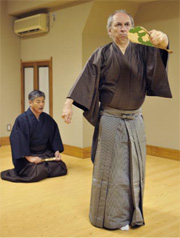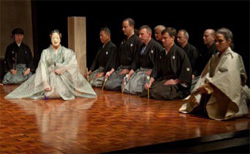Home > Highlighting JAPAN > Highlighting Japan NOVEMBER 2012 > When Less Is More
Highlighting JAPAN
[SERIES] MASTERS
When Less Is More
Noh ranks with kabuki as one of Japan's representative performing arts. As a stage drama developed in the fourteenth century, it is regarded as one of the oldest existing forms of theater, and was designated as a Masterpiece of the Oral and Intangible Heritage of Humanity by UNESCO in 2001. Richard Emmert has been studying noh for many years. He spoke with Toshio Matsubara.

Richard Emmert practices noh with his teacher.
Credit: YOSHIFUSA HASHIZUME
Having fallen under noh's spell, Richard Emmert, an American professor at Musashino University's Faculty of Literature, has been researching noh for more than forty years.
Emmert's first encounter with noh dates back to when he was a sophomore at Earlham College in Indiana. At a seminar on noh he had joined casually, he found himself performing in an English language noh play called St. Francis, and on the strength of his vocalization and poise was chosen to play the shite.
While the English-language noh play was entirely unknown overseas, the performance was successful, and with the support of the Ford Foundation a film of the play was even made. In 1970 Emmert studied at a Japanese university for a year where he learned traditional Japanese music such as the shakuhachi. After graduating from Earlham College, Emmert returned to Japan in 1973 to continue studying Japanese traditional music and noh. Then, Emmert made the chance discovery that St. Francis, in which he had performed, would be screened in Tokyo. Going to the screening was what determined his fate.

Theatre Nohgaku players perform the English-language noh play Pagoda in London in 2009.
Credit: CLIVE BARDA
In 1974, the following year, Emmert entered the Department of Musicology at Tokyo University of the Arts, where he conducted research on noh. Simultaneously, he continued to take practical lessons on shimai (dancing and movement) and utai (singing) and later began taking practical lessons on all the instruments of noh including the kotsuzumi (shoulder drum), otsuzumi and taiko (stick drum).
"In noh, the performers dance amid a 'intense calm,' and that's where it overflows with energy. What flows through the dancing is not 'tension' but rather an 'intensity,' and what produces that intensity is the form," explains Emmert. "Noh never uses realistic expressions like singing or moving about normally. Everything is expressed according to a prescribed form. While you'll also find stylistic expression in opera and dance, there is no other art that demands such rigid adherence to form as noh."
Since the 1980s, Emmert has devoted himself to popularizing English-language noh plays, and has been involved in the composing, musical direction and performance of various such plays. Since 1991, Emmert has run the Noh Training Project, with workshops in Pennsylvania in the United States and Reading in England, and in 2000 launched Theatre Nohgaku, a noh performance group comprising foreigners as well as Japanese living in foreign countries. Theatre Nohgaku began performing English-language noh plays from 2002, and to date has toured the United States, England, France, Beijing, Hong Kong and Japan.
Emmert says, "We want to steadily prune away the waste while expressing the 'less is more' world that is unique to noh. We're still a long way off, but it would be wonderful thing for English-language noh to someday become as widespread as opera."
© 2009 Cabinet Office, Government of Japan






